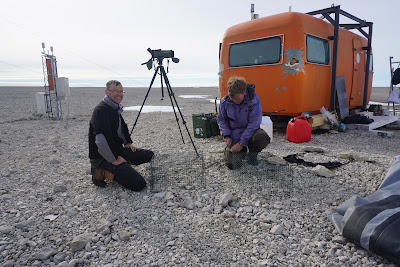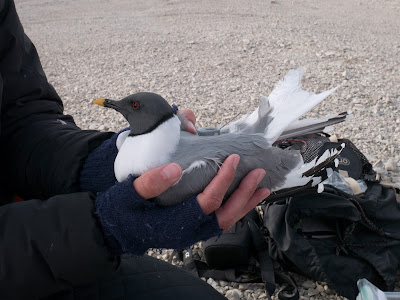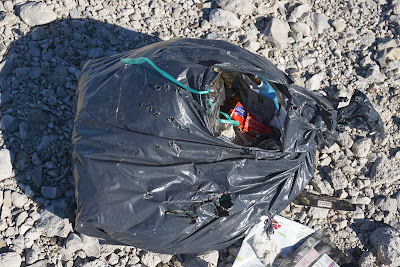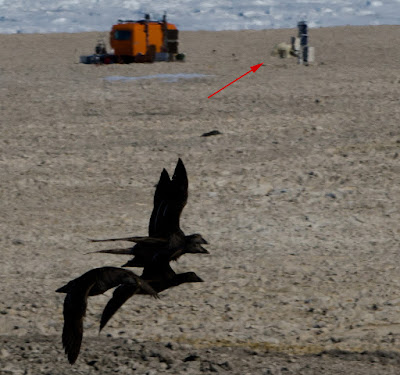In late June a party of three: Morten Frederiksen (Aarhus University, DK), Arne Andersson (CAnMove) and Jannie Fries Linnebjerg (Former CAnMove, now Aarhus University) went to the High Arctic desert to participate in a project initiated by Aarhus University. The aim was to investigate the foraging areas of the two Arctic seabird species: Ivory gull (Pagophila eburnea) and Sabine’s gull (Xema sabini).
These two species only breed in the Arctic, so in order to find them, we had to postpone the Scandinavian summer-life and move to a small caravan in Northeast Greenland for three weeks in July. Ivory gulls and Sabine’s gulls breed in small colonies and are known to breed on the islands of Henrik Krøyer Holme, approx. 15 km off the mainland of Northeast Greenland. The area is extremely remote, which means logistic challenges, such as chartered flights from Svalbard to the Danish airbase Station Nord, and airlift with a small Twin Otter aircraft to the study site.
 |
| The team is ready for take-off from Station Nord
to Henrik Krøyer Holme. |
 |
The orange caravan (the camp site), kindly lent to us by the Danish
Meteorological Institute.
|
Henrik Krøyer Holme is located close to the North East Water polynya, or area of recurring open water in the pack ice. However, in some years the islands remain linked to the mainland by fast ice far into the summer, and this was the case in 2017. This meant that terrestrial predators such as Arctic foxes (Alopex lagopus) had access to the islands. Many birds choose not to risk breeding under these conditions, and instead wait for a better year.
This was the case for the ivory gulls, which did not breed at all on the islands this year, but fortunately, (at least for us!) the Sabine’s gulls struggled on with their breeding. This gave us the opportunity to deploy GPS loggers on eight breeding birds, and we could follow their whereabouts by remotely downloading positions from the loggers.
 |
Several days were spent wandering about the island, trying to locate the
breeding birds.
The main island is about 10 km2, so there was quite
a lot of ground to cover. |
 |
Catching the
birds turned out to be more difficult than expected, so a lot of time and
energy went into
modifying traps and trying all sorts of different catching
methods. |
 |
| A Sabine’s gull equipped with a GPS data logger
on a leg-loop harness. |
Along with the work, there was of course also time to enjoy the harsh but exotic polar landscape and wildlife, like spotting walruses (Odobenus rosmarus) and narwhals (Monodon monoceros) close to the ice edge. And the Arctic fox, although making life difficult for birds and scientists, is very cute!
 |
| Arctic fox with an Eider egg. |
 |
Armed to the teeth. We never saw a polar bear, but did have one visiting our
camp when we were out in the field. |
 |
Polar bears are normally very curious and cautious when encountering new
things.
Polar bears do not like raw oats… |
 |
| Nor toilet bins… |
 |
| And our rubbish was not that interesting to the polar bear either…luckily. |
 |
| The photographer is busy shooting eiders and does not see the polar bear in the
background... |
 |
The landscape at Henrik Krøyer Holme is proper Arctic desert, with very little
vegetation.
Only six species of flowering plants have been registered on Henrik
Krøyer Holme.
One of them is the Arctic poppy (Papaver radicatum). |
 |
| Arne trying to get a close-up picture of an angry Arctic tern. |
 |
The rough terrain was hard on our boots. After four days, Mortens sole had
pretty
much come off the boot and he had to screw it back on. |
Three interesting and nice weeks had come to an end. And I think we were all
slightly relieved when the plane finally arrived :)
Arne & Jannie










Inga kommentarer:
Skicka en kommentar